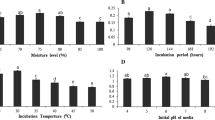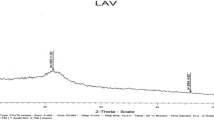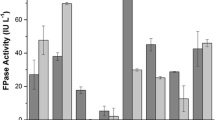Abstract
The present study deals with the cultivation of Trichoderma sp. for the production of cellulase in lignocellulosic materials. The highest cellulase activity was determined under optimal conditions of pH (5.0), incubation temperature (30 °C), inocula concentration (2 x 108 spores mL-1) and particle size (500 μm). Maximum activity for raw palm kernel cake (PKC), defatted PKC, and vegetable waste (VW) substrates were achieved as 6.9 FPU g−1, 16.1 FPU g−1 and 50.1 FPU g−1 correspondingly. It was observed that defatted PKC served as a better substrate than raw PKC for cellulase activity. A comparative study for the production of enzymes via solid state fermentation (SSF) indicated that cellulase activity produced by Trichoderma was about 1-fold higher in PKCs. However, Bacillus cereus scored 2-folds higher activity than VW substrates. On the basis of the significant yield of cellulase activity, palm oil industry wastes can be successfully used for the production of cellulase. Thus, environmental pollution can be controlled by utilizing palm oil industrial wastes to generate value-added product (cellulase).




Similar content being viewed by others
References
Abu-Sharar TM, Al-Karablieh EK, Haddadin MJ (2012) Role of virtual water in optimizing water resources management in Jordan. Water Resour Manag 26:3977–3993
Al-Gheethi AA, Ismail N (2014) Biodegradation of pharmaceutical wastes in treated sewage effluents by Bacillus subtilis 1556WTNC. Environl Process 1:459–481
Ali A, Sandi S (2014) Application of Ammoniation-fermentation technology based on palm plantation waste for increasing productivity of Pampangan buffalo. APCBEE Procedia 8:93–98
Al-Khashman OA (2009) Chemical evaluation of Ma’an sewage effluents and its reuse in irrigation purposes. Water Resour Manag 23:1041–1053
Awafo V, Chahal D, Simpson B (2000) Evaluation of combination treatments of sodium hydroxide and steam explosion for the production of cellulase-systems by two T. Reesei mutants under solid-state fermentation conditions. Bioresour Technol 73:235–245
Beldman G, Leeuwen MF, Rombouts FM, Voragen FG (1985) The cellulase of Trichoderma Viride. Eur J Biochem 146:301–308
Bradley PP, Priebat DA, Christensen RD, Rothstein G (1982) Measurement of cutaneous inflammation: estimation of neutrophil content with an enzyme marker. J Invest Dermatol 78:206–209
Buenrostro FJ, De La Garza-Toledo H, Ibarra-Junquera V, Aguilar CN (2010) Juice extraction from mango pulp using an enzymatic complex of Trichoderma sp. produced by solid-state fermentation. Food Sci Biotechnol 19:1387–1390
Bushra R, Naushad M, Adnan R, Md S, Ansari M, Ahmed A (2015) Electrical and Optical Properties of Synthesized Composite Material Polyaniline-Ti (IV) Arsenophosphate. Asian J Chem 27:1121
Caffall KH, Mohnen D (2009) The structure, function, and biosynthesis of plant cell wall pectic polysaccharides. Carbohydr Res 344:1879–1900
Chandra M, Kalra A, Sharma PK, Kumar H, Sangwan RS (2010) Optimization of cellulases production by Trichoderma citrinoviride on marc of Artemisia annua and its application for bioconversion process. Biomass Bioenergy 34:805–811
Efaq A, Rahman NNNA, Nagao H, Al-Gheethi A, Shahadat Md, Kadir, M. A. (2015). Supercritical carbon dioxide as non-thermal alternative technology for safe handling of clinical wastes. Environl Process 2:797–822.
Fujii T, Fang X, Inoue H, Murakami K, Sawayama S (2009) Enzymatic hydrolyzing performance of Acremonium cellulolyticus and Trichoderma Reesei against three lignocellulosic materials. Biotechnol Biofuels 2:24
Gautam S, Bundela P, Pandey A, Khan J, Awasthi M, Sarsaiya S (2011) Optimization for the production of cellulase enzyme from municipal solid waste residue by two novel cellulolytic fungi. Biotechnol Res Int 2011:1–8
Ghose T (1987) Measurement of cellulase activities. Pure Appl Chem 59:257–268
Goyal A, Ghosh B, Eveleigh D (1991) Characteristics of fungal cellulases. Bioresour Technol 36:37–50
Ibrahim C (2008) Development of applications of industrial enzymes from Malaysian indigenous microbial sources. Bioresour Technol 99:4572–4582
Jain CK, Malik DS, Yadav AK (2016) Applicability of plant based biosorbents in the removal of heavy metals: a review. Environl Process 3:495–523
Jørgensen H, Kristensen JB, Felby C (2007) Enzymatic conversion of lignocellulose into fermentable sugars: challenges and opportunities. Biofuels Bioprod Biorefin 1:119–134
Kashyap P, Sabu A, Pandey A, Szakacs G, Soccol CR (2002) Extra-cellular L-glutaminase production by Zygosaccharomyces rouxii under solid-state fermentation. Process Biochem 38:307–312
Keesari T, Ramakumar K, Prasad MBK, Chidambaram S, Perumal P, Prakash D, Nawani N (2015) Microbial evaluation of groundwater and its implications on Redox condition of a multi-layer sedimentary aquifer system. Environl Process 2:331–346
Khosrokhavar R, Griffiths S, Wolf KH (2014) Shale gas formations and their potential for carbon storage: opportunities and outlook. Environl Process 1:595–611
Koyani RD, Sanghvi GV, Rajput KS (2011) Comparative study on the delignification of Azadirachta indica (L) Del., wood by Chrysosporium asperatum and Trichoderma harzianum. Int Biodeter Biodegr 65:179–184
Krishna C, Chandrasekaran M (1996) Banana waste as substrate for α-amylase production by Bacillus Subtilis (CBTK 106) under solid-state fermentation. Appl Microbiol Biotechnol 46:106–111
Kuhad RC, Gupta R, Singh A (2011) Microbial cellulases and their industrial applications. Enz Res 2011
Latifian M, Hamidi-Esfahani Z, Barzegar M (2007) Evaluation of culture conditions for cellulase production by two Trichoderma reesei mutants under solid-state fermentation conditions. Bioresour Technol 98:3634–3637
Lu W, Li D, Wu Y (2003) Influence of water activity and temperature on xylanase biosynthesis in pilot-scale solid-state fermentation by Aspergillus sulphureus. Enzym Microb Technol 32:305–311
Mansour MM, Salem MZ (2015) Evaluation of wood treated with some natural extracts and Paraloid B-72 against the fungus Trichoderma harzianum: wood elemental composition, in-vitro and application evidence. Int Biodeter Biodegr 100:62–69
Medve J (1997) Cellulose Hydrolysis by Trichoderma reesei cellulases: studies on adsorption, sugar production and synergism of cellobiohydrolase I. Lund University, II and endoglucanase II
Milala M, Shehu B, Zanna H, Omosioda V (2009) Degradation of agro-waste by cellulase from Aspergillus candidus. Asian J Biotechnol 1:51–56
Moslim R, Kamarudin N (2014) The use of palm kernel cake in the production of conidia and blastospores of Metarhizium anisopliae var. major for control of Oryctes Rhinoceros. J Oil Palm Res 26:133–139
Nabi S, Shahadat M, Bushra R, Shalla A, Azam A (2011) Synthesis and characterization of nano-composite ion-exchanger; its adsorption behavior. Colloids and Surfaces B 87:122–128
Nataraja S, Chetan D, Krishnappa M (2010) Effect of temperature on cellulose enzyme activity in crude extracts isolated from solid wastes microbes. Int J Microbiol Res 2:44
Norsalwani TT, Norulaini NN (2012) Utilization of lignocellulosic wastes as a carbon source for the production of bacterial cellulases under solid state fermentation. Inter J Environ Sci Develop 3:136–140
Ojumu TV, Solomon BO, Betiku E, Layokun SK, Amigun B (2003) Cellulase production by Aspergillus flavus Linn isolate NSPR 101 fermented in sawdust, bagasse and corncob. Afr J Biotechnol 2:150–152
Palonen H, Tjerneld F, Zacchi G, Tenkanen M (2004) Adsorption of Trichoderma Reesei CBH I and EG II and their catalytic domains on steam pretreated softwood and isolated lignin. J Biotechnol 107:65–72
Pandey A, Soccol CR, Mitchell D (2000) New developments in solid state fermentation: I-bioprocesses and products. Process Biochem 35:1153–1169
Pang P, Ibrahim D, Poppe L, Szakacs G, Che Omar I (2006) Production of cellulolytic enzymes by a newly isolated, Trichoderma sp. FETL c3-2 via solid state fermentation grown on sugar cane bagasse: palm kernel cake as substrates. Pak J Biol Sci 9:1430–1437
Philippi K, Tsamandouras N, Grigorakis S, Makris DP (2016) Ultrasound-assisted green extraction of eggplant peel (Solanum melongena) polyphenols using aqueous mixtures of glycerol and ethanol: optimisation and kinetics. Environl Process 3:369–386
Rahman NNNA, Md S, Won CA, Omar FM (2014) FTIR study and bioadsorption kinetics of bioadsorbent for the analysis of metal pollutants. RSC Adv 4:58156–58163
Rahman NNNA, Md S, Omar FM, Chew AW, Kadir MOA (2016) Dry Trichoderma biomass: biosorption behavior for the treatment of toxic heavy metal ions. Desalin Water Treat 57:13106–13112
Ramachandran S, Patel AK, Nampoothiri KM, Francis F, Nagy V, Szakacs G, Pandey A (2004) Coconut oil cake––a potential raw material for the production of α-amylase. Bioresour Technol 93:169–174
Ramos LP (1992) Steam pretreatment and enzymatic hydrolysis of Eucalyptus viminalis chips: Theses, University of Ottawa (Canada) 1910–2010.
Ramos LP (2003) The chemistry involved in the steam treatment of lignocellulosic materials. Quím Nov. 26:863–871
Ramos LP, Zandoná FA, Deschamps F, Saddler JN (1999) The effect of Trichoderma cellulases on the fine structure of a bleached softwood kraft pulp. Enzym Microb Technol 24:371–380
Ryu DD, Mandels M (1980) Cellulases: biosynthesis and applications. Enzym Microb Technol 2:91–102
Sabu A, Sarita S, Pandey A, Bogar B, Szakacs G, Soccol CR (2002) Solid-state fermentation for production of phytase by Rhizopus oligosporus. Appl Biochem Biotechnol 102:251–260
Shafawati SN, Siddiquee S (2013) Composting of oil palm fibres and Trichoderma spp. as the biological control agent: a review. Int Biodeter Biodegr 85:243–253
Shahadat M, Shalla A, Raeissi A (2012) Synthesis, characterization, and sorption behavior of a novel composite cation exchange adsorbent. Ind Eng Chem Res 51:15525–15529
Sola F, Vallejos A, López-Geta J, Pulido-Bosch A (2013) The role of aquifer media in improving the quality of seawater feed to desalination plants. Water Resour Manag 27:1377–1392
Srivastava S, Sharma YK (2014) Arsenic induced changes in growth and metabolism of black Gram seedlings (Vigna mungo L.) and the role of phosphate as an ameliorating agent. Environl Process 1:431–445
Sudiyani Y, Styarini D, Triwahyuni E, Sembiring KC, Aristiawan Y, Abimanyu H, Han MH (2013) Utilization of biomass waste empty fruit bunch fiber of palm oil for bioethanol production using pilot–scale unit. Energy Procedia 32:31–38
Tao S, Beihui L, Deming L, Zuohu L (1997) Effect of elevated temperature on Trichoderma Viride SL-1 in solid state fermentations. Biotechnol Lett 19:171–174
Teeri T, Koivula A, Linder M, Wohlfahrt G, Divne C, Jones T (1998) Trichoderma Reesei cellobiohydrolases: why so efficient on crystalline cellulose? Biochem Soc Trans 26:173–178
Van DBJ, De Vries RP (2011) Fungal enzyme sets for plant polysaccharide degradation. Appl Microbiol Biotechnol 91:1477–1492
Wan C, Zhao XQ, Guo SL, Alam MA, Bai FW (2013) Bioflocculant production from Solibacillus silvestris W01 and its application in cost-effective harvest of marine microalga Nannochloropsis oceanica by flocculation. Bioresour Technol 135:207–212
Wong H, Wan Zahari, M (1992) Characterization of oil-palm by-products as feed for ruminants. Proc. 15th. Annual Conference of the Malaysian Society of Animal Production.
Wong KK, Zahari MW (2011) Utilization of oil palm by-products as ruminant feed in Malaysia. J Oil Palm Res 23:1029–1035
Wyman CE (2008) Cellulosic ethanol: a unique sustainable liquid transportation fuel. MRS Bull 33:381–383
Zhang H, Sang Q (2012) Statistical optimization of cellulases production by Penicillium chrysogenum QML-2 under solid-state fermentation and primary application to chitosan hydrolysis. World J Microbiol Biotechnol 28:1163–1174
Acknowledgments
This work was supported by the research university grant of University Sains Malaysia (No.1001/PJJAUH/811198). Special thanks to United Fleet Palm Sdn. Bhd. and School of Industrial Technology for the materials and facilities provided for this research.
Author information
Authors and Affiliations
Corresponding authors
Rights and permissions
About this article
Cite this article
Lah, T.N.T., Norulaini, N.A.N., Shahadat, M. et al. Utilization of Industrial Waste for the Production of Cellulase by the Cultivation of Trichoderma via Solid State Fermentation. Environ. Process. 3, 803–814 (2016). https://doi.org/10.1007/s40710-016-0185-8
Received:
Accepted:
Published:
Issue Date:
DOI: https://doi.org/10.1007/s40710-016-0185-8




